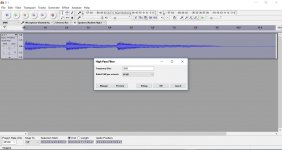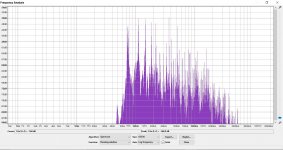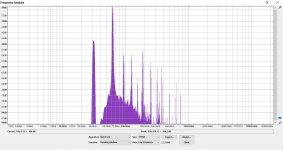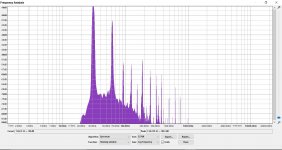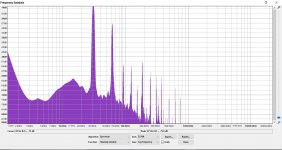Explains why the Frugel-Horn Lites do so well. They are definitly not doing the fundamental but are good at the 2nd & 3rd.
dave
That was my observation on hearing the Mk3s. You don't miss the <50Hz stuff unless you A/B with something that goes down there.
Chris
This is weird.
Applied a steep 55Hz HPF and initial impression is that this sounds 'dull' compared to the original, despite the FFT suggesting it should be otherwise. That 'twangyness' as the string vibrates has gone.
This is original track D1 that has been modified.
Applied a steep 55Hz HPF and initial impression is that this sounds 'dull' compared to the original, despite the FFT suggesting it should be otherwise. That 'twangyness' as the string vibrates has gone.
This is original track D1 that has been modified.
Attachments
Um... Mooly, your first pair of samples was in stereo, but the HPF'd one was mono. This accounts for the noticeable difference in timbre. 
Here's your D1 sample, after a brickwall FFT HPF @ 55 Hz, saved in stereo. When I compare this one to the original D1 on my TV speakers (little or no LF response), they sound virtually identical. When I pipe them over to the big system (w/subs), they sound... well, they sound damn close, more so than I expected. I think I can hear a bit more fundamental in the original - which is pretty funny when I consider the fact that the fundamental has been erased from the modified tones.
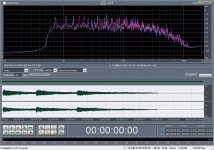
View attachment D 1 55Hz HPF Stereo.zip
[EDIT] A couple of additional random thoughts: First, having had a closer look at the spectrum of the original piano sample (note: the pic above is of course the HPF'd version and not the original), this all makes sense, since the fundamental is clearly 20-24 dB down from the level of the next several harmonics. I never realized the fundamental of a piano bass note was so relatively weak! (I'm pretty sure we'd get more difference if we tried this trick with a sample of a 32' Contre Bourdon organ pipe, heh.)
Here's your D1 sample, after a brickwall FFT HPF @ 55 Hz, saved in stereo. When I compare this one to the original D1 on my TV speakers (little or no LF response), they sound virtually identical. When I pipe them over to the big system (w/subs), they sound... well, they sound damn close, more so than I expected. I think I can hear a bit more fundamental in the original - which is pretty funny when I consider the fact that the fundamental has been erased from the modified tones.

View attachment D 1 55Hz HPF Stereo.zip
[EDIT] A couple of additional random thoughts: First, having had a closer look at the spectrum of the original piano sample (note: the pic above is of course the HPF'd version and not the original), this all makes sense, since the fundamental is clearly 20-24 dB down from the level of the next several harmonics. I never realized the fundamental of a piano bass note was so relatively weak! (I'm pretty sure we'd get more difference if we tried this trick with a sample of a 32' Contre Bourdon organ pipe, heh.)
Last edited:
This is weird.
Applied a steep 55Hz HPF and initial impression is that this sounds 'dull' compared to the original, despite the FFT suggesting it should be otherwise. That 'twangyness' as the string vibrates has gone.
This is original track D1 that has been modified.
The 'twangyness' is encoded in those very low level bumps below 55 Hz that were filtered out. Those bumps are very low wrt the fundamental, and by themselves would be completely inaudible. But that low frequency content is needed to properly reproduce the envelope of higher level tones that are definitely audible. The good news is that at such low energies, you don't need a woofer from Hell to do the job - just one that can produce modest output accurately down as low as possible.
Well I listened to the piano tracks on my main system for the first time today. Jim is right, D1 and the brickwall filtered version are very close (B&W703's).
The 'twangyness' (lol) that seems missing in my filtered version was very apparent (apparent as in missing) when I was originally listening on laptop speakers. So it does seem something is going on
So lets try it this is the Ruffatti organ in Davies Symphony Hall.
this is the Ruffatti organ in Davies Symphony Hall.
(if you listen via small speakers (laptop) then don't be surprised to not hear anything much in the last half of the tracks)
30_36 and 55_36 are the filter frequency 30 and 55Hz and roll off in db per octave (36db)
The 'twangyness' (lol) that seems missing in my filtered version was very apparent (apparent as in missing) when I was originally listening on laptop speakers. So it does seem something is going on
I never realized the fundamental of a piano bass note was so relatively weak! (I'm pretty sure we'd get more difference if we tried this trick with a sample of a 32' Contre Bourdon organ pipe, heh.)
So lets try it
(if you listen via small speakers (laptop) then don't be surprised to not hear anything much in the last half of the tracks)
30_36 and 55_36 are the filter frequency 30 and 55Hz and roll off in db per octave (36db)
Attachments
So lets try itthis is the Ruffatti organ in Davies Symphony Hall.
WONDERFUL! Supposed to be the largest concert hall organ, although not too much competition for that. Almost all the St Saens Sym 3 recordings have dubbed organs.
That's one of my favourite tracks but you've set it up as a very definitive test. Wonderful. Let me explain.
First of all, some readers may not have heard that the pedal note changes after the flute ends. As Mooly slyly hints above. Did you notice before reading it here? So I mention it here just in case you mistakenly think your pseudo-horn actually plays low notes.
The test is to get a friend to secretly choose one of the three Mooly bands and you have to guess which. (No cheating like looking at your amp power lamps or all those swell Christmas tree lamps on a Behringer DSP or by making the level so that the flute pipe is louder than a whisper.) Fair enough?
With good bass (and good perceptual judgment), you ought to be able to do this "absolutely" but even if you can do it only "relatively" (by quickly A-B'ing bands one after another) you've still won a cigar.*
In the event you trust yourself, you can see for yourself alone too, of course.
My guess is that some (many?) folks will surprised they can't tell either filtered band from the real thing. And they will stop emoting about their bass and buy a calibrated mic.
B.
*on my system with just-OK low bass, pretty close call to identify the 30 Hz filter and, if barely noticeable on this piece, not important for 99.3% of my music collection (or if calculated in minutes, 99.999%).
Last edited:
Cheers again for this, Mooly.
A few observations, hope this isn't too pedantic.
The sample is a low C pedal note at a 16' pitch, which has a fundamental frequency of 32 Hz. There is no "music" in the sample below that frequency, unless you consider the ambient sound in a location recording to be a part of the "music" - to which I would reply, "Fair enough."
But I would also point out that the level of this sub-32 Hz ambient sound is about -48 dB below the fundamental of the low pedal note, which appears at about 14 seconds in, and is fairly quiet to begin with. Ben is correct to remind that this is gonna be hard to hear at a normal playback level, even if your system has proper bass extension to that region.
I'd suggest that what Mooly is providing with the 30 Hz HP-filtered organ sample, and also the 55 Hz HP piano sample, are not so much excellent examples of bass extension, but rather of masking effects. And 2 different types of masking to boot: In the piano sample, we hear the dominant harmonic structure of the bass string reducing the fundamental to near-irrelevance. In the organ, it's music vs noise floor.
On the other hand, that 55 Hz HPF'd organ sample is all about the bass extension (or lack thereof), hehe.
P.S. Just for the hell of it, here are the spectra of the 3 organ samples, overlaid in Cool Edit Pro (green=unfiltered, red=30 Hz, blue=55 Hz):
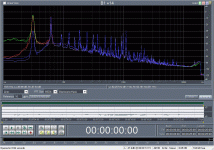
A few observations, hope this isn't too pedantic.
The sample is a low C pedal note at a 16' pitch, which has a fundamental frequency of 32 Hz. There is no "music" in the sample below that frequency, unless you consider the ambient sound in a location recording to be a part of the "music" - to which I would reply, "Fair enough."
But I would also point out that the level of this sub-32 Hz ambient sound is about -48 dB below the fundamental of the low pedal note, which appears at about 14 seconds in, and is fairly quiet to begin with. Ben is correct to remind that this is gonna be hard to hear at a normal playback level, even if your system has proper bass extension to that region.
I'd suggest that what Mooly is providing with the 30 Hz HP-filtered organ sample, and also the 55 Hz HP piano sample, are not so much excellent examples of bass extension, but rather of masking effects. And 2 different types of masking to boot: In the piano sample, we hear the dominant harmonic structure of the bass string reducing the fundamental to near-irrelevance. In the organ, it's music vs noise floor.
On the other hand, that 55 Hz HPF'd organ sample is all about the bass extension (or lack thereof), hehe.
P.S. Just for the hell of it, here are the spectra of the 3 organ samples, overlaid in Cool Edit Pro (green=unfiltered, red=30 Hz, blue=55 Hz):

Last edited:
Many thanks to Jim for the measurements and insightful discussion.Just for the hell of it, here are the spectra of the 3 organ samples, overlaid in Cool Edit Pro (green=unfiltered, red=30 Hz, blue=55 Hz)
But without proceeding with the instrumentation these tests deserve, I suspect the unfiltered clip has more bass (or is just louder) that the 30 Hz HPF.
Two crude reasons:
(1) various level indicator lamps on my woofer devices are on longer/brighter, and
(2) my ancient Radio Shack SPL has the loudest part of the 30 Hz HPF down almost a dB compared to unfiltered clip (which ordinarily isn't too detectable).
So possibly there really is a non-negligible non-noise sound removed by the 30 Hz HPF.
B.
No you're right Ben, there is slightly less actual bass note in the 30 Hz filtered sample. The difference is there in the FFT plots, although with mine the vertical resolution is pretty squished, so it's hard to see; but it's definitely 1 or 2 dB. At 32 Hz, this would be the "thigh" side of the knee point of a HPF that's down 3 dB @ 30 Hz.
There is a way in Cool Edit to show the FFT separately, but I can't remember how to pry it loose from the main window.
There is a way in Cool Edit to show the FFT separately, but I can't remember how to pry it loose from the main window.
To add something that i know from my "sound engineer" period. Vinyl is limited to 30Hz-18kHz (technical limitation) within 3dB. On the higher frequencies it contains info on higher frequencies, but the slope down starts arround 18kHz. Below 30Hz vinyl can't reproduce the sound for technical reasons. This means that music before the cd (before the mid 80's at least) no music had info below 30Hz. For most pop music, 40 or 50Hz is already enough. Dub, Jungle and dubstep dj's, who all play music based on subbass use scoop horns that if used in rows of 4, go to +/- 32Hz, and that is already very low for a high power system and hits you hard on the chest when they go that low on high level (even on low level).
With digital PCM sampling (normal mainstream digital), the border is 20Hz, altough there are systems that go lower.
I think if you can cover 25Hz with a sub, for music you're fully covered. Below there is not much info, and it's mostly rumble. Only organs can go lower (but it's rare they do). For movies 20Hz is still the lowest needed and 25 or 30Hz will also cover 99.99% of the sound.
And off course you will always have freaks that disagree and try to go lower, but for 99,99% of the people, it's not needed, only a waste of money and effort to try.
With digital PCM sampling (normal mainstream digital), the border is 20Hz, altough there are systems that go lower.
I think if you can cover 25Hz with a sub, for music you're fully covered. Below there is not much info, and it's mostly rumble. Only organs can go lower (but it's rare they do). For movies 20Hz is still the lowest needed and 25 or 30Hz will also cover 99.99% of the sound.
And off course you will always have freaks that disagree and try to go lower, but for 99,99% of the people, it's not needed, only a waste of money and effort to try.
- Status
- This old topic is closed. If you want to reopen this topic, contact a moderator using the "Report Post" button.
- Home
- Loudspeakers
- Subwoofers
- How LOW should we go... For Music and for Movies ?
